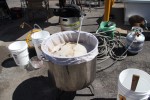Water makes up the vast majority of any beer. Generally 90% or more. No brewing water, however, is as simple as pure H2O. There are always going to be features of that water that impact either slightly or drastically the effectiveness of that water at helping the brewer craft a beer worth drinking. Beyond being free from contaminants, the major features of water that matter to a brewer are pH, residual alkalinity, and flavor impact of certain ions. While these three points are all inextricably linked, this article will focus, whenever possible, on the impact of specific ions. Because ions cannot be added on their own but rather must be added in groups of equally but oppositely charged cations and anions dissolved in solution, this will all be a bit theoretical. Practical application requires a bit more mathematical agility than we will showcase here. If the process intrigues you, let me know and we can delve a little more into the nuts and bolts of equation application in another article.
In his book Water: A Comprehensive Guide for Brewers, John Palmer reminds us, “There are rules, that are meant to enforce the guidelines, that are derived from the principles, which suffice until you really understand what is going on.” That is all just to say that you can get pretty far in your use of salt ions in brewing water with a fairly cursory and even sometimes fundamentally flawed understanding of how they work. Obviously you will be best off with a complete understanding of the complex chemical interplay of all the pieces of the puzzle. But nobody got time for that. For now, let’s stick to the realm of rules/guidelines/principles and leave really understanding for another time.
When approaching the ions in your brewing water, I first recommend that you remember the real reason you care enough to approach all this ion crap in the first place: good beer. That must always be the goal. If your own practical experience tells you something that runs contrary to the theory you read here or anywhere else, stick with your practical observations. Put (or omit) whatever you please in your beer if the result is good beer. I’ll also include here a little note for those of us in Louisville, KY: we have great brewing water. You don’t need an RO system unless you are a crazy person. Our water has enough ions to perform many of the basic functions of those ions without having so many as to risk going overboard as long as reason governs. You can make most beers without doing anything to the water, or you can add some substantial additions without worrying about overdoing it. Relax. Now, on with the show.
Calcium is our first and arguably most important ion. When in doubt, add some more calcium. It’s good for so many things in beer. In addition to aiding in a favorable pH drop in the mash, calcium promotes mash enzyme activity, assists coagulation and precipitation in the boiling wort, provides nutrition for yeast to build cell walls, and promotes flocculation. The beer miracle drug, calcium is primarily added via calcium sulfate (CaSO4), commonly occurring as gypsum, or calcium chloride (CaCl2). Too much calcium will not produce a distinct flavor of its own, but it may produce a mineral character and will generally bring with it a substantial number of negatively charged ions that may produce undesirable flavors or effects.
Magnesium is another useful ion as it provides necessary nutrition for yeast, but it is only needed as an intentional addition in the rarest of circumstances. Barley wort will naturally contain more than enough magnesium ions to get the job done.
The rest of the ions we are going to touch on have somewhat less objectively verifiable results. The effects are a little more subjective in the sense that they do not provide clear mechanisms but rather have a track record of certain perceived impacts. For example, the sodium from ordinary (non-iodized) table salt, even when added in amounts too small to be tasted as “salty,” do impact the perception of mouthfeel. Most people report a greater fullness of malt flavors with a small sodium presence. Chloride has a very similar effect to that of sodium, making table salt (NaCl) an ideal tiny addition to beers that could use a bump to their sweeter malt flavors without actually altering the malt profile in any way. Lastly, sulfate ions can substantially increase the hop impact of beers that are meant to have a lasting, powerful hop character. Operating as a bit of a blunt blade, sulfate ions can brighten and magnify both the intensity and duration of perceived bitterness but can get in the way of delicate or soft hop flavors. It is worth noting that these impacts are generally less significant than the base flavor they are meant to modify. Sulfate ions will not impact hopiness more than hops themselves. Because they are supporters rather than primary flavors, they are often best used as a balancing tool. Sulfate can improve stouts and porters by enhancing balance just as sodium chloride can benefit IPAs and pale ales by shining up the malt just slightly. As with every other ion, moderation is key. A little bit can go a long way. Also, just to reiterate, brew what you like. If you find that your beers are stellar with no additions, keep it up. If you like your beers to have giant floating globs of gypsum, that’s your prerogative. I don’t think I need a glass, though.
Until next time, faithful readers, thanks for reading, and happy drinks!
P.S. Remember to let me know if you have some specific topic you would like me to babble about next time. You can tell me in person, by e-mail, or in the comments right down below.






